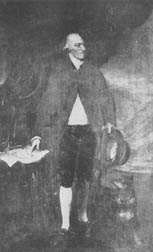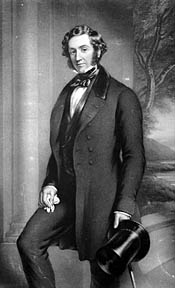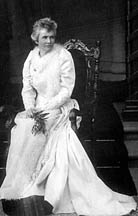Quarry Proprietors - The Penrhyn
Dynasty
Slaves, Sugar and Slate
 It was
Richard Pennant, (1737? -1808), pictured right, who first
set the industry on its entrepreneurial phase. Though of
Flintshire lineage, Richard Pennant was a Liverpool merchant
prince who founded his fortune on the slave trade and inherited
estates in Jamaica. On December 6, 1765 he married Ann Susannah,
daughter and heiress of General Hugh Warburton (1695-1771)
who held part of the moiety of the Penrhyn estate. In 1783, he was raised to the peerage of the
Kingdom of Ireland as Baron Penrhyn of Penrhyn in the
County of Louth. Holding an Irish peerage, he was not
disqualified from sitting in the House of Commons, which he did.
This is a brilliant example of the political intrigues that were
prevalent in those times. He sat as member for Peterfield from
1761-1767, for Liverpool from 1768-1780 and again for Liverpool
from 1785-1790. It was
Richard Pennant, (1737? -1808), pictured right, who first
set the industry on its entrepreneurial phase. Though of
Flintshire lineage, Richard Pennant was a Liverpool merchant
prince who founded his fortune on the slave trade and inherited
estates in Jamaica. On December 6, 1765 he married Ann Susannah,
daughter and heiress of General Hugh Warburton (1695-1771)
who held part of the moiety of the Penrhyn estate. In 1783, he was raised to the peerage of the
Kingdom of Ireland as Baron Penrhyn of Penrhyn in the
County of Louth. Holding an Irish peerage, he was not
disqualified from sitting in the House of Commons, which he did.
This is a brilliant example of the political intrigues that were
prevalent in those times. He sat as member for Peterfield from
1761-1767, for Liverpool from 1768-1780 and again for Liverpool
from 1785-1790.
He employed as his steward William Williams*, (1738-1817), pictured lower right, to
whom must be given the credit for suggesting the
development of galleries in the Penrhyn Quarry to Pennant. William Williams
ran the quarry on a purely capitalistic basis, thus changing
permanently the infrastructure of the industry. Before his
retirement on a pension in 1803 from an indebted Lord Penrhyn, he
was to administer efficiently the modes of production, exporting
and the selling of slate among many other responsibilities. His
contribution cannot be
ignored.
* See Dafydd Glyn Jones' book,
Un o Wyr y Medra - Bywyd a gwaith William Williams,
Llandygai (1999)
‘Castle’ building
On Lord Penrhyn’s death in 1808, and his widow in 1816, the
Penrhyn estate descended to George Hay Dawkins (1763-1840),
his cousin, who inherited not only the whole of the Penrhyn
estate, but also the Jamaica plantations and the wealth that came
with them. He not only started expanding the estate by purchasing
various parcels of land, but also by the buying of most of the
hotels in the city of Bangor. Also, between 1821 and 1836, he was
responsible for the building of the present Castell Penrhyn to the designs of Thomas Hooper.
The Penrhyn Dynasty
 On his death in 1840 he had named his daughter,
Juliana, as heiress to all his properties and his son in
law, Colonel Edward Gordon Douglas (1800-86), pictured
right, as the second in line to the succession so long as they
assumed the surname and arms of Pennant, to which they readily
agreed. Two years later, she died at Pisa, and her widowed
husband inherited. From 1841-1865 he represented the county of
Caernarfonshire in Parliament. He was a very energetic landowner
who extended the estate not only in Wales, but also by purchases
in England. By 1871, he had the largest rental in the county. He
entertained Victoria at Penrhyn in 1859 and was raised to the
Peerage of the ‘United Kingdom’ in 1866 as Baron Penrhyn of
Llandegai. His son was elected unopposed to his seat in the House
of Commons. On his death in 1886, he was succeeded as owner of
Castell Penrhyn, the Penrhyn estate, the Penrhyn quarry, Wicken
Park as well as the plantations on Jamaica, by his oldest son,
George Sholto Gordon Douglas-Pennant, (1836-1907.) On his death in 1840 he had named his daughter,
Juliana, as heiress to all his properties and his son in
law, Colonel Edward Gordon Douglas (1800-86), pictured
right, as the second in line to the succession so long as they
assumed the surname and arms of Pennant, to which they readily
agreed. Two years later, she died at Pisa, and her widowed
husband inherited. From 1841-1865 he represented the county of
Caernarfonshire in Parliament. He was a very energetic landowner
who extended the estate not only in Wales, but also by purchases
in England. By 1871, he had the largest rental in the county. He
entertained Victoria at Penrhyn in 1859 and was raised to the
Peerage of the ‘United Kingdom’ in 1866 as Baron Penrhyn of
Llandegai. His son was elected unopposed to his seat in the House
of Commons. On his death in 1886, he was succeeded as owner of
Castell Penrhyn, the Penrhyn estate, the Penrhyn quarry, Wicken
Park as well as the plantations on Jamaica, by his oldest son,
George Sholto Gordon Douglas-Pennant, (1836-1907.)
There is an anecdotal story told by W.J. Parry, (1842-1927) regarding an
incident during the 1865, which is probably a key fact to the
character of the second Lord Penrhyn.
| Suddenly I heard Colonel Pennant
call me, -“Parry, come back. Call the men back…tell them this is
my son and heir, George” After I had translated, he added, “Tell
them to beware not to offend George, for if they do, he will
never forgive; he can never forgive.” After I had translated, he
added, -“It is so George, is it not? He looked over his shoulder,
and without turning round said, -“Let them try, and they will
see”… This one fact hid so many of his virtues.
(Hanes fy Mywyd a’m Gwaith, W.J. Parry.)
|
Born in 1836, George Sholto Gordon Douglas-Pennant inherited
the parliamentary seat for the County of Caernarfon, vacated when
his father was raised to the peerage. Two years later, he lost it
to the Liberal cause. He retrieved the seat in 1874 only to lose
again in 1880. From all accounts he was an excellent landowner
but his relations with his quarrymen degenerated into industrial
disputes, culminating in the terrible strike of 1900-03. He
regarded that any threat to his authority had to be met head
on.
 The
financial empire managed from Castell Penrhyn was immense. Not
only was he the third biggest landowner in Wales but was also the
owner of one of the largest slate quarries. His profits of
£133,000 from the quarry in 1899 were twice as big as his
rentals. In 1890 Carmen Sylva, pictured right,
Queen of Romania stayed at the castle and planted a tree to mark
the occasion. Four years later, Albert Edward, Prince of Wales
stayed there with his wife and daughters on their foray to the
National Eisteddfod, held that year at Caernarfon. The
financial empire managed from Castell Penrhyn was immense. Not
only was he the third biggest landowner in Wales but was also the
owner of one of the largest slate quarries. His profits of
£133,000 from the quarry in 1899 were twice as big as his
rentals. In 1890 Carmen Sylva, pictured right,
Queen of Romania stayed at the castle and planted a tree to mark
the occasion. Four years later, Albert Edward, Prince of Wales
stayed there with his wife and daughters on their foray to the
National Eisteddfod, held that year at Caernarfon.
Dying in 1907, the squire of Penrhyn was succeeded by his son
Edward Sholto Douglas-Pennant, 1864-1927 (third Baron
Penrhyn of Llandygai). Outlying parts of the estate began to be
sold off to pay death duties in 1907, and more sales took place
in 1910, 1912 and 1925. Hugh Napier Douglas-Pennant,
(1894-1949) thus inherited a smaller estate. Death duties also
forced him to sell property.
The Jamaica estates were sold in 1933 followed by more property
in Caernarfonshire in 1939. On his death in 1949, the title and
estate were split. His niece, Lady Janet Douglas Pennant
(1923-97) inherited Castell Penrhyn, the quarry and the estate.
Two years later she reached an agreement with the Treasury by
which Castell Penrhyn and a large part of the estate were
transferred to them in lieu of death duties. In turn, the
Treasury transferred them to the National Trust. Separating the
quarry and estate interests in the same year, a limited company
was formed to run the quarry. In 1973 she sold her remaining
fifty one per cent shareholding in the company and the link
between the Penrhyn family and the quarry were severed.
|